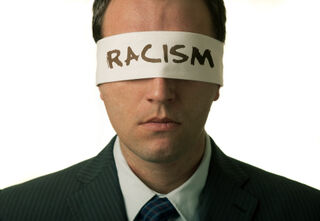Bias
Colorblind Ideology Is a Form of Racism
A colorblind approach allows us to deny uncomfortable cultural differences.
Posted December 27, 2011 Reviewed by Jessica Schrader
Key points
- Colorblind ideology aims to treat individuals as equally as possible, without regard to race.
- Colorblindness also denies the negative racial experiences of people of color, rejects their heritage, and invalidates their unique perspectives.
- An alternative to colorblindness is multiculturalism, an ideology that acknowledges, highlights, and celebrates ethnoracial differences.
What is racial colorblindness?
Racial issues are often uncomfortable to discuss and rife with stress and controversy. Many ideas have been advanced to address this sore spot in the American psyche. Currently, the most pervasive approach is known as colorblindness. Colorblindness is the racial ideology that posits the best way to end discrimination is by treating individuals as equally as possible, without regard to race, culture, or ethnicity.
At its face value, colorblindness seems like a good thing—really taking MLK seriously on his call to judge people on the content of their character rather than the color of their skin. It focuses on commonalities between people, such as their shared humanity.
However, colorblindness alone is not sufficient to heal racial wounds on a national or personal level. It is only a half-measure that in the end operates as a form of racism.
Problems with the colorblind approach

Racism? Strong words, yes, but let's look the issue straight in its partially unseeing eye. In a colorblind society, white people, who are unlikely to experience disadvantages due to race, can effectively ignore racism in American life, justify the current social order, and feel more comfortable with their relatively privileged standing in society (Fryberg, 2010). Most people of color, however, who regularly encounter difficulties due to race, experience colorblind ideologies quite differently. Colorblindness creates a society that denies their negative racial experiences, rejects their cultural heritage, and invalidates their unique perspectives.
Let's break it down into simple terms: Colorblind = "People of color—we don't see you (at least not that bad 'colored' part)." As a person of color, I like who I am, and I don't want any aspect of that to be unseen or invisible. The need for colorblindness implies there is something shameful about the way God made me and the culture I was born into that we shouldn't talk about. Thus, colorblindness has helped make race into a taboo topic that polite people cannot openly discuss. And if you can't talk about it, you can't understand it, much less fix the racial problems that plague our society.
Colorblindness is not the answer
Many Americans view colorblindness as helpful to people of color by asserting that race does not matter (Tarca, 2005). But in America, most people of color will explain that race does matter, as it affects opportunities, perceptions, income, and so much more. When race-related problems arise, colorblindness tends to individualize conflicts and shortcomings, rather than examining the larger picture with cultural differences, stereotypes, and values placed into context. Instead of resulting from an enlightened (albeit well-meaning) position, colorblindness comes from a lack of awareness of racial privilege conferred by Whiteness (Tarca, 2005). White people can guiltlessly subscribe to colorblindness because they are usually unaware of how race affects people of color and American society as a whole.
Colorblindness in a psychotherapeutic relationship
How might colorblindness cause harm? Here's an example close to home for those of you who are psychologically minded. In the not-so-distant past, in psychotherapy a client's racial and ethnic remarks were viewed as a defensive shift away from important issues, and the therapist tended to interpret this as resistance (Comas-Diaz & Jacobsen, 1991). However, such an approach hinders the exploration of conflicts related to race, ethnicity, and culture. The therapist doesn't see the whole picture, and the client is left frustrated.
A colorblind approach effectively does the same thing. Blind means not being able to see things. I don't want to be blind. I want to see things clearly, even if they make me uncomfortable. As a therapist, I need to be able to hear and "see" everything my client is communicating on many different levels. I can't afford to be blind to anything. Would you want to see a surgeon who operated blindfolded? Of course not. Likewise, a therapist should not be blinded either, especially to something as critical as a person's culture or racial identity. By encouraging the exploration of racial and cultural concepts, the therapist can provide a more authentic opportunity to understand and resolve the client's problems (Comas-Diaz & Jacobsen, 1991).
Nonetheless, I have encountered many fellow therapists who ascribe to a colorblind philosophy. They ignore race or pretend its personal, social, and historical effects don't exist. This approach ignores the incredibly salient experience of being stigmatized by society and represents an empathetic failure on the part of the therapist. Colorblindness does not foster equality or respect; it merely relieves the therapist of his or her obligation to address important racial differences and difficulties.
Multiculturalism is better than blindness
Research has shown that hearing colorblind messages predict negative outcomes among White people, such as greater racial bias and negative affect; likewise colorblind messages cause stress in people of color, resulting in decreased cognitive performance (Holoien et al., 2011). Given how much is at stake, we can no longer afford to be blind. It's time for change and growth. It's time to see.
The alternative to colorblindness is multiculturalism, an ideology that acknowledges, highlights, and celebrates ethnoracial differences. It recognizes that each tradition has something valuable to offer. It is not afraid to see how others have suffered as a result of racial conflict or differences.
So, how do we become multicultural? The following suggestions would make a good start (McCabe, 2011):
- Recognizing and valuing differences,
- Teaching and learning about differences, and
- Fostering personal friendships and organizational alliances.
Moving from colorblindness to multiculturalism is a process of change, and change is never easy, but we can't afford to stay the same.
For those of you who offered feedback about this post, I am sorry but the comment area had to be closed due to a number of hateful, threatening, and racist comments. There were too many responses for me to reply to each one individually, but I did draft a collective response that you can read here: Why People Cling to Racist Ideas.
References
Comas-Diaz, L., and Jacobsen, F. M. (1991). Clinical Ethnocultural Transference and Countertransference in the Therapeutic Dyad. American Journal of Orthopsychiatry, 61(3), 392-402.
Fryberg, S. M. (2010). When the World Is Colorblind, American Indians Are Invisible: A Diversity Science Approach. Psychological Inquiry, 21(2), 115-119.
Holoien, D. S., and Shelton, J. N. (October 2011). You deplete me: The cognitive costs of colorblindness on ethnic minorities. Journal of Experimental Social Psychology, 10.1016/j.jesp.2011.09.010.
McCabe, J. (2011). Doing Multiculturalism: An Interactionist Analysis of the Practices of a Multicultural Sorority. Journal of Contemporary Ethnography, 40 (5), 521-549.
Tarca, K. (2005). Colorblind in Control: The Risks of Resisting Difference Amid Demographic Change. Educational Studies, 38(2), 99-120.




